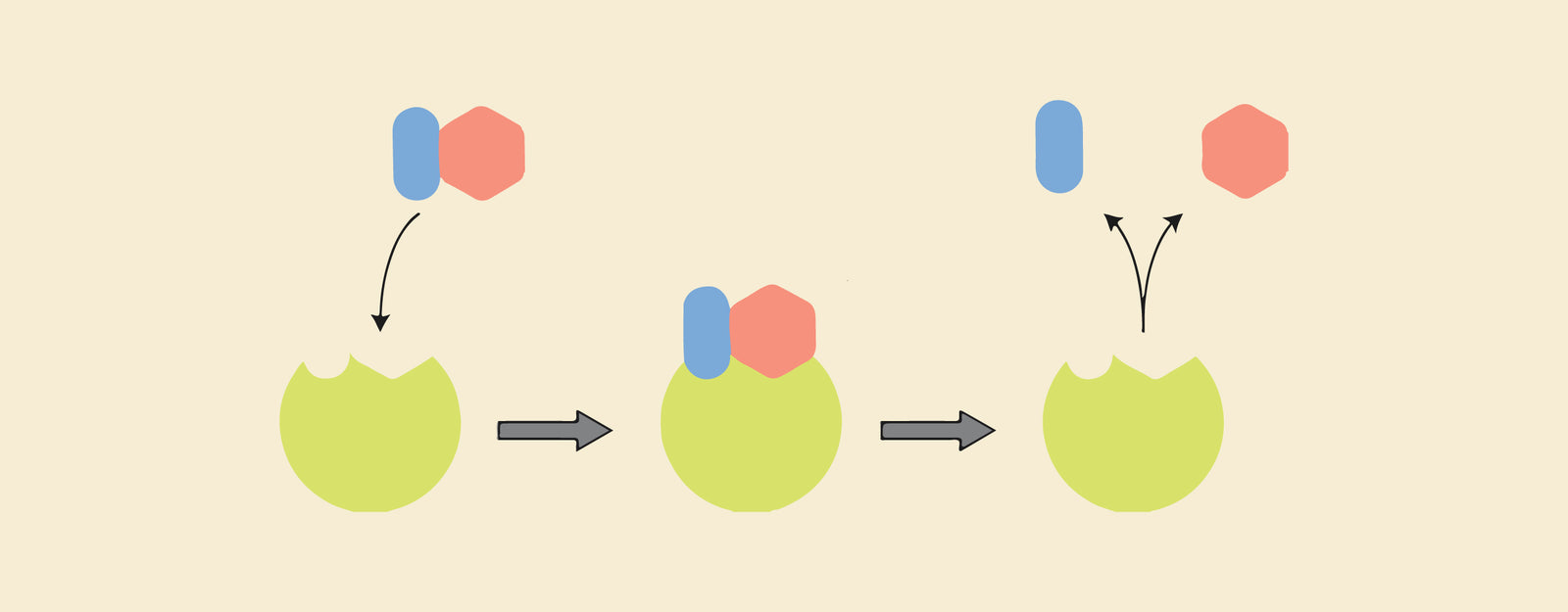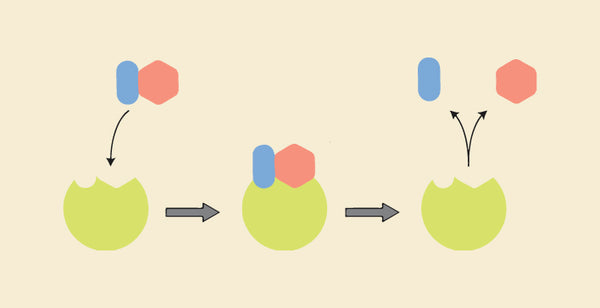Difference Between Protein And Enzyme: Proteins and enzymes are fundamental components of living organisms, each playing unique roles in cellular functions and biochemical processes. While proteins serve as essential building blocks for the structure and function of cells, enzymes are a specialized subset of proteins that catalyze and accelerate chemical reactions. Understanding the differences between proteins and enzymes is key to appreciating their distinct functions within biological systems.
Difference Between Protein and Enzyme
Here's a table summarizing the main differences between proteins and enzymes:
|
Feature |
Protein |
Enzyme |
|
Definition |
Large, complex molecules composed of amino acids linked in a specific sequence. |
A specialized protein that acts as a biological catalyst, facilitating chemical reactions. |
|
Structural Role |
Serves as structural components of cells and tissues, contributing to cellular architecture. |
Primarily catalytic; structural role is secondary, if present at all. |
|
Functional Diversity |
Exhibits diverse functions, such as acting as enzymes, antibodies, transporters, and signaling molecules. |
Primarily involved in catalyzing specific biochemical reactions. |
|
Catalytic Role |
Typically not catalytic; proteins may have some catalytic activity, but it is not their primary function. |
Acts as a biological catalyst, accelerating the rate of chemical reactions by lowering the activation energy. |
|
Specificity |
Generally less specific; function is broad and varies among different types of proteins. |
Highly specific, often binding to a particular substrate at a specialized active site. |
|
Reusability |
Not designed for reuse in catalytic cycles; functions more as a static structural element. |
Reusable in multiple catalytic cycles, as it remains unchanged after the reaction. |
|
Examples |
Hemoglobin (oxygen transport), collagen (connective tissue support), antibodies (immune response). |
Catalase (breaks down hydrogen peroxide), amylase (digests carbohydrates), DNA polymerase (synthesizes DNA strands). |
|
Location |
Present throughout the cell and body, contributing to cellular structure and function. |
Often localized in specific cellular compartments or organelles where their catalytic activity is required. |
|
Regulation |
Regulation is diverse and depends on the specific function of the protein. |
Regulation involves factors such as substrate concentration, pH, and temperature affecting enzymatic activity. |
Check out the best deals on Scrubs Suits Here!
What is Protein?
Proteins are large, complex molecules that play a crucial role in the structure, function, and regulation of cells, tissues, and organs within living organisms. They are one of the essential macromolecules found in all forms of life, including animals, plants, bacteria, and fungi. Proteins are involved in a wide array of biological processes and functions.
Key Features of Proteins:
- Structural Components: Proteins serve as structural components, providing support and maintaining the shape of cells and tissues. Examples include collagen in connective tissues and actin and myosin in muscle fibers.
- Enzymatic Functions: Many proteins act as enzymes, which are biological catalysts that facilitate and accelerate chemical reactions in the body. Enzymes are crucial for various metabolic processes and cellular functions.
- Transport: Proteins are involved in the transport of molecules across cell membranes and throughout the bloodstream. Hemoglobin, for example, transports oxygen in the blood.
- Immune Response: Antibodies are proteins that play a key role in the immune system, recognizing and neutralizing foreign substances, such as bacteria and viruses.
- Cell Signaling: Proteins participate in cell signaling pathways, transmitting signals that regulate various cellular activities, including growth, differentiation, and apoptosis (programmed cell death).
- Nutrient Storage: Proteins can store essential nutrients. Ferritin, for instance, stores and releases iron in a controlled manner.
- Hormones: Certain proteins, such as insulin, act as hormones, regulating physiological processes like blood sugar levels.
The structure of a protein is critical to its function. Proteins are made up of chains of amino acids, and the sequence of these amino acids determines the protein's unique three-dimensional shape and, consequently, its function. The diversity of proteins allows for a vast range of biological activities, making them indispensable to life.
What is Enzyme?
Enzymes are specialized proteins that act as biological catalysts, facilitating and accelerating chemical reactions within living organisms. Catalysts are substances that increase the rate of a chemical reaction without being consumed in the process. Enzymes play a crucial role in various physiological processes, and they are essential for the proper functioning of cells and metabolic pathways.
Key Features of Enzymes:
- Catalytic Activity: Enzymes speed up chemical reactions by lowering the activation energy required for the reactions to occur. This acceleration allows processes to proceed at a biologically relevant rate.
- Specificity: Enzymes are highly specific to the reactions they catalyze. Each enzyme typically works on a specific substrate or a group of structurally related substrates.
- Substrate Binding: Enzymes have an active site where the substrate (the molecule undergoing the reaction) binds. The specificity of the active site ensures that only the correct substrate can bind to the enzyme.
- Reusability: Enzymes are not consumed in the reactions they catalyze. After facilitating a reaction, they remain unchanged and are available to catalyze additional reactions.
- Temperature and pH Sensitivity: Enzymes have optimal temperature and pH conditions for their activity. Changes outside these ranges may affect their efficiency.
- Regulation: Enzyme activity is often regulated in response to the needs of the cell or organism. This regulation ensures that metabolic processes are finely tuned and responsive to changing conditions.
Enzymes are involved in a wide range of biological activities, including digestion, energy production, DNA replication, and cellular signaling. The specificity and efficiency of enzymes make them crucial components of cellular function, allowing organisms to carry out complex biochemical processes with remarkable precision.
Get the Perfect Lab Coats for your Medical Profession
Similarity Between Protein and Enzyme
Proteins and enzymes share several similarities, mainly because enzymes are a specific type of protein with specialized functions. Here are some commonalities between proteins and enzymes:
- Composition: Enzymes are a subset of proteins. Both proteins and enzymes are made up of chains of amino acids linked together by peptide bonds. The unique sequence of amino acids determines the structure and function of each protein, including enzymes.
- Amino Acid Structure: Enzymes, like all proteins, are composed of amino acids. The arrangement of these amino acids in the polypeptide chain contributes to the overall structure and function of the protein.
- Biological Macromolecules: Proteins, including enzymes, are considered biological macromolecules. They are large and complex molecules that play essential roles in various biological processes.
- Folded Structure: Both proteins and enzymes have specific three-dimensional structures. The folding of the polypeptide chain into a particular shape is crucial for their function. Enzymes, in particular, have active sites with specific shapes for substrate binding.
- Catalytic Activity: Enzymes are proteins with catalytic activity. While not all proteins act as enzymes, enzymes are a subset of proteins that facilitate chemical reactions. The catalytic activity of enzymes is a key function that distinguishes them from other proteins.
- Role in Biological Processes: Proteins, including enzymes, are involved in numerous biological processes. Enzymes catalyze reactions that are vital for metabolism, energy production, signal transduction, and other cellular functions. Other proteins contribute to structural support, transport, immune response, and more.
- Regulation: Both proteins and enzymes can be regulated within a cell or organism. Cellular mechanisms control the synthesis, degradation, and activity of proteins, including enzymes, to maintain proper physiological function.
While proteins encompass a broad category of molecules with diverse functions, enzymes represent a specific subset of proteins designed for catalytic activities. The similarities in their basic structural components and involvement in biological processes highlight the interconnected roles that proteins and enzymes play in the functioning of living organisms.















